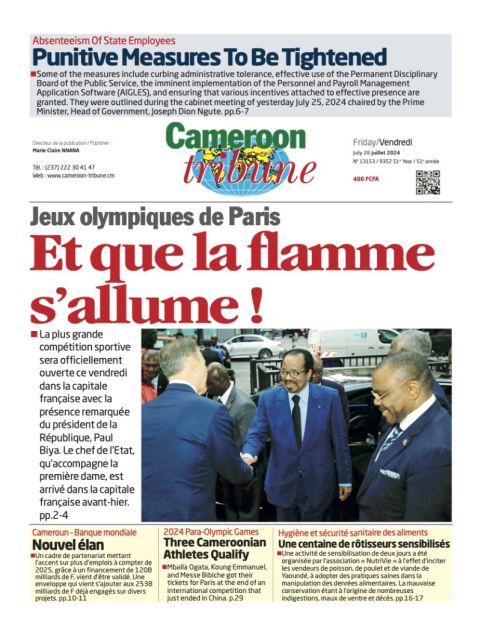Valorise Alternative Water, Energy Sources
- Par Godlove BAINKONG
- 07 avril 2022 12:05
- 0 Likes
The government of Cameroon has rolled out what some analysts have qualified as a contingency plan to bail the population out of shouting energy and water supply deficit both at urban, semi-urban and rural areas. The “Measures Taken by the Government to Improve Water and Electricity Supply,” as Energy and Water Resources Minister baptised the strategy, consists in completing ongoing projects and undertaking new ones in the respective sectors.
Visibly, government is bent on materialising mostly giant projects in which much has been invested or is being pumped to attempt journeying the population out of darkness and thirst. Clearly so as the gap between demand and supply of the precious services is wide and the rate at which the population is growing and cities expanding suggest the problem of adequate energy and water supply could even be more acute if durable solutions are not quickly sought.
Without carrying out any scientific survey to state clearly what percentage of the population is highly awaiting the fruition of the much-trumpeted government’s plan, one can arguably see in the Minister’s outing; declarations that rekindled hopes of better days ahead. People going for days and weeks without the vital basic utilities is no longer news and the adverse effects that their insufficient, irregular and sometimes utter absences have on society remain scary.
Households and companies which carry the cross of the poor supply of water and energy, sometimes on daily basis, are therefore hoping that the government’s bailout plan would not remain on paper or at least when implemented could take them out of darkness and thirst. Their wishes are, to say the least, legitimate given the crucial role water and energy play in the life of man and society. It is common knowledge that energy availability is the pillar for social and economic progress and once people are unsure of water to drink, their health is at risk and the economy threatened to its roots given that health, we are told, is wealth.
Ascertaining that citizens are well served with these basic but precious services, as government is grappling to do, amidst serious difficulties though, is a pointer that the population is not abandoned to itself. It must be said however that the problems of efficient water and energy supply in the country are so complex that a one-fit-all strategy would be difficult, if not impossible, to live up to expectation. Like the Minister indicated during the press briefing, Cameroon, in matters of electricity supply, is configured in three major networks; and the problems arise differently depending on whether one is in the Southern Interconnected Network, the Northern Interconnected Network or the Eastern Interconnected Network. As the member of government opined, and rightly so, the Southern Interconnected Network, made up of six southern regions ( Centre, Littoral, West, North West, South West and South), has the advantage of having huge potential for hydroelectricity, by far the main source of electricity production in Cameroon. Most of these potentials are found in the Sanaga river basin, where major hydroelectricity projects have been completed or are underway.
Focusing almost wholly on hydroelectricity which is just one among nine other sources of power generation, as is the case now with so much pumped into hydroelectricity dam construction, wouldn’t be tackling the energy supply problem head-on. Worse still, some of these projects appear to have been poorly crafted or their feasibility studies were tampered with somehow. That hundreds of thousands of billions of scarce liquidity are spent on constructing a dam only to realise at term that the energy produced could not be transported to needy households and industries or that some of the power plants cannot function at full capacity for want of transportation lines are the difficult-to-comprehend realities. Disclosing that between 2010 and 2021, the funds mobilized for investment in the electricity sector represent a little more than FCFA 3,500 billion; that is, FCFA 2,000 billion in production, FCFA 1,000 billion in electricity transmission and FCFA 500 billion in electricity distribution is shocking looking at the current poor energy supply situation almost across the country.
Be it energy or water, it should be said that Cameroon disposes huge potentials and it would be paradoxical that with water, water everywhere the population are still unable to conveniently live. It is understandable that the giant water and energy generation projects have the propensity to provide the population with substantial quality and quantity services but a blind eye shouldn’t be given to alternative sources likewise community initiatives. Communities and their respective populations are ingenious and government could capitalise on this creativity to trigger partnerships susceptible to partly solving the challenging water and energy supply equation. For electricity, so many rural areas or new layouts are into solar energy with panels that are lighting bulbs and powering some household appliances. Renewable energy sources like solar, wi...
Cet article complet est réservé aux abonnés
Déjà abonné ? Identifiez-vous >
Accédez en illimité à Cameroon Tribune Digital à partir de 26250 FCFA
Je M'abonne1 minute suffit pour vous abonner à Cameroon Tribune Digital !
- Votre numéro spécial cameroon-tribune en version numérique
- Des encarts
- Des appels d'offres exclusives
- D'avant-première (accès 24h avant la publication)
- Des éditions consultables sur tous supports (smartphone, tablettes, PC)
Reactions
De la meme catégorie
Intelligence artificielle : saisir les opportunités, contenir les menaces
- 22 juil. 2024 14:04
- 0 likes












Commentaires